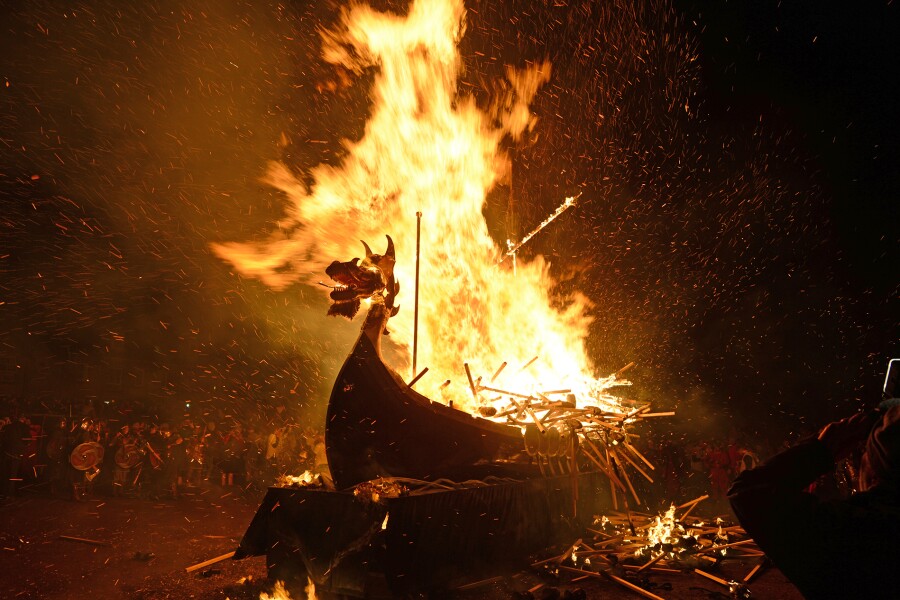Every year on the last Tuesday in January, Europe’s Norse heritage comes ablaze during the fiery celebration of Up Helly Aa in Scotland.
Held in Lerwick, the capital of the Shetland Islands (a sub-Arctic archipelago located off mainland Scotland), the traditional festival dates back to the 1800s. It commemorates the Vikings who occupied the Shetland Islands before Scottish rule—and it also mimics their rowdy Yule season rituals.
This year’s celebrations came to a head on Tuesday, January 29, when large crowds gathered along the snow-covered streets of Lerwick to witness the spectacular recreation of Shetland’s Viking heritage.

Up Helly Aa is celebrated in Lerwick every year on the last Tuesday in January.
Photo by Robert Wishart
Viking “squads” take to the streets
On Up Helly Aa Day, “squads” of costume-clad participants known as “guizers” embark on a cross-town procession, making visits to local schools, hospitals, and the Shetland Museum. The march—which begins at 8:30 a.m.—is headed by the festival’s leading group, the Jarl Squad. The guizers in this squad wear specially crafted Viking-style attire, and their appointed chief, known as the Guizer Jarl, is decorated with a suit of armor that’s been passed down through generations.

Viking-style armor is designed as far as two years in advance of the festival.
Photo by Robert Wishart
When night falls, up to 1,000 outfitted men trail behind the Jarl Squad in a torch-lit parade that follows a life-size replica of a traditional Viking longboat (known as “the galley”) across Lerwick. Accompanied by a local brass band, the Up Helly Aa procession—which begins at the town hall at 7:30 p.m.—passes a route lined with spectators, including both Shetland residents and visitors. (The public is free to view the morning marches and evening procession; no tickets are required.)
After the procession passes through town, the armor-clad guizers enter the festival’s designated “burning site.” Up Helly Aa squad members then throw their torches into the Viking ship replica, transforming the galley into a massive bonfire. As the ship burns, Lerwick’s guizers chant traditional Up Helly Aa songs such as “The Norseman’s Home.” For safety reasons, the public is not permitted to enter the burning site, but the spectacle can be viewed from a distance.

Crowds gather to see the 2019 Jarl Squad pose for photos with their galley ship in Lerwick, Shetland.
Photo by Robert Wishart
After the fiery festivities come to a close, the Up Helly Aa revelry moves to “halls” across Lerwick, where ticketed celebrations continue into the evening and sometimes into the following day (which is considered a public holiday in the Shetland Islands). Many Up Helly Aa parties operate on an invitation-only basis, but some halls sell tickets through Lerwick’s local tourist office and the Shetland Tourist Board.
A display of sub-Arctic skill and spirit
Although Up Helly Aa lasts for just one day each year, Lerwick locals prepare for the festivities well ahead of time. Committed volunteers commence construction of the galley and torches many months before the midwinter festival begins, and the Jarl Squad starts designing their Viking-style armor as far as two years in advance.

This year, Guizer Jarl John Nicolson led the fiery Up Helly Aa celebration.
Photo by Robert Wishart
Beyond helping to organize the “northern Mardi Gras” (as Up Helly Aa is sometimes referred to), being involved in the day-of activities is considered a deeply local privilege. Participants must be Shetland residents for five years before they can be permitted to join a squad and partake in the processions.
Because Up Helly Aa is rooted in not-exactly-modern Viking traditions, some of the festival’s parameters are still considered restrictive. In rural parts of the Shetland Islands where Up Helly Aa is also celebrated, women can partake in squads—but the Lerwick event, which is the biggest, still features a male-only procession. (In 2015, Lerwick’s Up Helly Aa committee appointed its first female Guizer Jarl in the festival’s long-standing history, but in 2018, a group of Shetland women campaigned—to no avail—for the inclusion of mixed-gender squads in Lerwick’s Up Helly Aa processions.)
Maybe this year’s burning of the galley will forge a brighter future for the Lerwick event and spark a move toward the inclusion of all types of Viking enthusiasts in future Up Helly Aa festivities.

The torch-lit procession culminates in the burning of a life-size Viking ship replica.
Photo by Yolanda Bruce
Up Helly Aa 2019 took place in Lerwick on Tuesday, January 29. Various—albeit smaller—Up Helly Aa celebrations occur across the Shetland Islands throughout February and March. Learn more here.
>>Next: Scotland Is Now Home to One of the World’s Best New Road Trips











